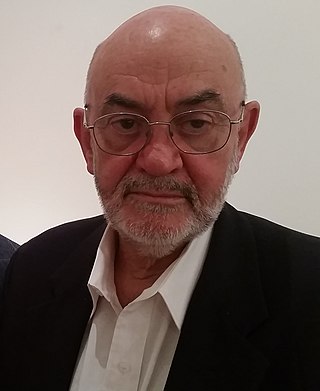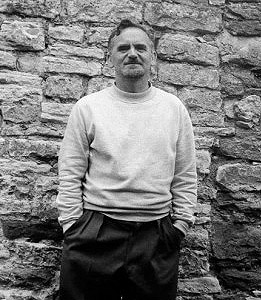Related Research Articles
Dale Frank is an Australian contemporary artist best known for his biomorphic abstract paintings. His practice has included found object-sculptures, performance installations, drawings and most recently paintings with sculptural elements. Frank lives and works in the Hunter Valley, New South Wales, Australia.

Rick Amor is an Australian artist and figurative painter. He was an Official War Artist for Australia.
Euan Macleod is a New Zealand-born artist. Macleod was born in Christchurch, New Zealand and moved to Sydney, Australia in 1981, where he lives and works. He received a Certificate in Graphic Design from Christchurch Technical College in 1975 and a Diploma in Fine Arts (Painting) from the University of Canterbury in 1979. As well as pursuing his art he also teaches painting at the National Art School in Sydney.

The Antipodeans were a group of Australian modern artists who asserted the importance of figurative art, and protested against abstract expressionism. Though they staged but a single exhibition in Melbourne during August 1959, they were noted internationally.

William Scott was a prominent abstract painter from Northern Ireland, known for his themes of still life, landscape and female nudes. He is the most internationally celebrated of 20th-century Ulster painters. His early life was the subject of the film Every Picture Tells a Story, made by his son James Scott.
Robert Jacks was an Australian painter, sculptor and printmaker.
Euan Heng, is an artist who is now living and working in Melbourne, Australia.
Colin Robert Andrew Laverty was an Australian medical practitioner and was the first to confirm that the human papillomavirus was much more common in the cervix than previously thought and, in 1978, he suggested that this virus be considered as possibly involved in the causation of cervical cancer. He was also a prolific art collector.

Constance Stokes was an Australian modernist painter who worked in Victoria. She trained at the National Gallery of Victoria Art School until 1929, winning a scholarship to continue her study at London's Royal Academy of Arts. Although Stokes painted few works in the 1930s, her paintings and drawings were exhibited from the 1940s onwards. She was one of only two women, and two Victorians, included in a major exhibition of twelve Australian artists that travelled to Canada, the United Kingdom and Italy in the early 1950s.
Terry Batt is an Australian artist and sculptor.
Kevin Lincoln is an Australian artist.
Jan Senbergs is an Australian artist and printmaker of Latvian origin.
Angela Brennan is an Australian painter.
Paul Boston is an Australian artist.
Sydney Ball was an Australian abstract painter. He has been called ‘one of Australia’s leading colour abstract painters. He has also been credited with bringing large scale abstract expressionist paintings, or Color Field paintings, to Australia.
Andrew John Sibley was an English-born Australian artist. Sibley has been the subject of three books and is commonly listed in histories and encyclopedias of Australian art as a significant figurative painter of the mid and late 20th century.
Bradd Westmoreland is an Australian painter.

Lisa Reid is an Australian artist, known primarily for her highly detailed figurative works in a variety of mediums. Reid has worked from her Northcote-based studio at Arts Project Australia since 2000, where she held her first solo show in 2015. She has exhibited widely, both nationally and internationally and her work was recently selected for the landmark exhibition Painting. More Painting, at the Australian Centre for Contemporary Art, Melbourne. Her work is held in the collection of the National Gallery of Australia.
Malaluba Gumana is an Australian Aboriginal artist from northeast Arnhem Land, who has gained prominence through her work in painting and the production of larrakitj, the memorial poles traditionally used by Yolngu people in a mortuary ceremony.
Diena Georgetti is an Australian contemporary artist born in Alice Springs, Australia and currently based in Melbourne, Australia. Her works have been displayed in galleries across Australia, including the National Gallery of Victoria, the Institute of Modern Art in Brisbane and the Art Gallery of South Australia. She was selected for inclusion in the National Gallery of Australia's Know My Name exhibition 2021-22.
References
- ↑ "Gunter Chrisdtmann: Abstract painter embraced realism". Smh.com.au. Retrieved 27 December 2013.
- 1 2 3 The Commercial Gallery. "Gunter Christmann" . Retrieved 5 July 2013.
- 1 2 Morse, Meredith. "Time underfoot: Gunter Christmann's recent paintings". Art & Australia. Retrieved 5 July 2013.
- ↑ Art Nomad. "Gunter Sylvester Christmann" . Retrieved 12 July 2013.
- ↑ "Gunter Christmann Biography". Niagara Galleries. 26 June 2017.